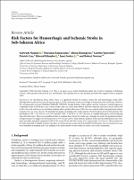| dc.contributor.author | Namale, Gertrude | |
| dc.contributor.author | Kamacooko, Onesmus | |
| dc.contributor.author | Kinengyere, Alison | |
| dc.contributor.author | Yperzeele, Laetitia | |
| dc.contributor.author | Cras, Patrick | |
| dc.contributor.author | Ddumba, Edward | |
| dc.contributor.author | Seeley, Janet | |
| dc.contributor.author | Newton, Robert | |
| dc.date.accessioned | 2021-04-30T13:37:08Z | |
| dc.date.available | 2021-04-30T13:37:08Z | |
| dc.date.issued | 2018-05-31 | |
| dc.identifier.citation | Namale, G., Kamacooko, O., Kinengyere, A., Yperzeele, L., Cras, P., Ddumba, E., Seeley, J. and Newton, R., 2018. Risk factors for hemorrhagic and ischemic stroke in sub-Saharan Africa. Journal of tropical medicine, 2018. | en_US |
| dc.identifier.issn | 1687-9686 | |
| dc.identifier.issn | 1687-9694 | |
| dc.identifier.uri | http://hdl.handle.net/20.500.12280/2814 | |
| dc.description.abstract | Introduction. In sub-Saharan Africa (SSA), there is a significant burden of ischemic stroke (IS) and hemorrhagic stroke (HS), although data on risk factors for each type are sparse. In this systematic review we attempt to characterize the risk factors. Methods. We systematically reviewed (PubMed, EMBASE, WHOLIS, Google Scholar, Wiley online, and the Cochrane Central Register of Controlled Trials (CENTRAL)) case-control studies and case series from 1980 to 2016 that reported risk factors for IS and/or HS in SSA. For each risk factor we calculated random-effects pooled odds ratios (ORs) for case-control studies and pooled prevalence estimates for case series. Results. We identified 12 studies, including 4,387 stroke patients. Pooled analysis showed that patients who had diabetes (OR = 2.39; 95% CI: 1.14–5.03) and HIV (OR = 2.46 (95% CI: 1.59–3.81) were at a significantly greater risk of suffering from all stroke types. There were insufficient data to examine these factors by stroke type. Among case series, the pooled prevalence of hypertension was higher for HS than for IS (73.5% versus 62.8%), while diabetes mellitus (DM) and atrial fibrillation (AF) were more prevalent among IS compared to HS (15.9% versus 10.6% and 9.6% versus 2.3%, respectively). Conclusions. There remain too few data from SSA to reliably estimate the effect of various factors on the risk of IS and HS. Furthermore, the vast majority of cases were identified in hospital and so are unlikely to be representative of the totality of stroke cases in the community. | en_US |
| dc.language.iso | en | en_US |
| dc.publisher | HINDAWI LTD , ADAM HOUSE, 3RD FLR, 1 FITZROY SQ, LONDON, ENGLAND, W1T 5HF | en_US |
| dc.relation.ispartofseries | Journal of tropical medicine; | |
| dc.subject | Risk factors | en_US |
| dc.subject | Hemorrhagic stroke | en_US |
| dc.subject | Ischemic stroke | en_US |
| dc.subject | Sub-Saharan Africa | en_US |
| dc.title | Risk Factors for Hemorrhagic and Ischemic Stroke in Sub-Saharan Africa | en_US |
| dc.type | Article | en_US |


